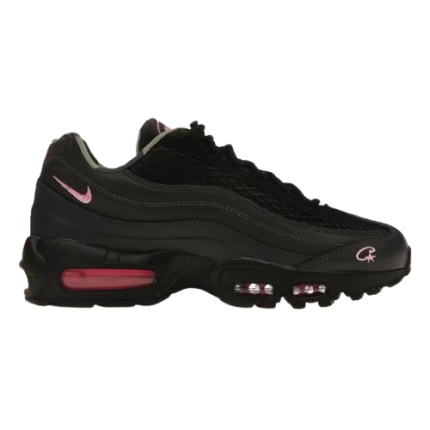The Nike Air Max line is a cornerstone of sneaker culture, and few models embody its evolution and cultural relevance more than the Air Max 95 and the Air Max 90. These silhouettes, though born just five years apart, reflect drastically different design philosophies, historical contexts, and cultural influences. This article takes a detailed look at both iconic sneakers—tracing their origins, innovations, and enduring impact on fashion, music, and street culture.
The Birth of the Air Max Legacy
Before diving into the Air Max 90 and 95 specifically, it’s important to understand the origin of the Air Max series. The story began in 1987 with the launch of the Air Max 1, the first sneaker to showcase visible Air cushioning. Designed by the legendary Tinker Hatfield, the Air Max 1 was revolutionary for merging performance technology with bold design. Over time, the Air Max line became a canvas for innovation and self-expression, culminating in several models that changed the trajectory of sneaker culture.
Air Max 90: Bold, Fast, and Fearless
Released: 1990
Designer: Tinker Hatfield
Original Name: Air Max III (renamed Air Max 90 later)
The Air Max 90, originally known as the Air Max III, was a continuation of Hatfield’s bold vision. It introduced larger visible Air units, sharper lines, and more aggressive paneling than its predecessors. Its defining feature—the bright “Infrared” colorway—gave the sneaker instant visibility and appeal.
Design and Innovation
The Air Max 90 was designed with speed and performance in mind. The exaggerated midsole, layered uppers, and increased heel height gave it a fast-forward look. Its upper mixed mesh, leather, and suede, allowing for vibrant color blocking. The visible Air unit was larger and more structurally integrated than in the Air Max 1 or 89.
Nike’s use of thermoplastic heel support and durable polyurethane midsole in the 90 gave it increased comfort and stability. It was a running shoe—but quickly adopted by trendsetters, skaters, and DJs for its bold aesthetic.
Cultural Impact
While rooted in performance, the Air Max 90 exploded in the UK rave and grime scenes during the late ’90s and early 2000s. Known there as the “110s” (a nod to their price of £110), they became a symbol of urban fashion and street identity. The shoe also earned massive respect across Europe, Japan, and eventually in the U.S. as retro culture picked up steam.
Air Max 95: A Radical Reinvention
Released: 1995
Designer: Sergio Lozano
Nicknames: “110s,” “Neons,” “95s”
Five years later, Nike took a radical design leap with the Air Max 95, helmed by Sergio Lozano, a designer with a background in tennis and ACG gear rather than running shoes. The 95 introduced visible forefoot Air units—a first for Nike—and presented an anatomical, muscle-inspired design never seen before in the sneaker world.
Design and Innovation
Lozano’s inspiration came from the human body: the layered suede and mesh upper resembled muscle fibers, the eyelets looked like ribs, and the spine-shaped midsole reinforced the anatomical theme. The signature gradient design of the upper gave the shoe a bold visual identity. The OG “Neon” colorway—grey, black, and fluorescent green—became instantly iconic.
Technologically, the Air Max 95 was groundbreaking. It used visible Air in both the heel and forefoot, and its multi-density foam midsole offered unprecedented comfort and responsiveness for runners and casual wearers alike.
Cultural Impact
The 95 had a massive cultural resonance, especially in urban communities across the U.S. and UK. Like the 90, it became a staple in UK streetwear and was also embraced in hip-hop circles in New York and beyond. Its aggressive styling, higher retail price, and futuristic design gave it a premium, almost rebellious edge.
Over time, it became a symbol of luxury streetwear and was adopted by artists and athletes alike. Collaborations with designers and artists (including Stash, Dave White, Comme des Garçons, and more) solidified the Air Max 95 as a true icon.
Air Max 90 vs Air Max 95: A Style Showdown
While both models share a lineage, they reflect very different personalities.
| Feature | Air Max 90 | Air Max 95 |
|---|---|---|
| Design Theme | Speed, geometry, bold color blocking | Anatomy, layers, gradient effect |
| Technology | Visible heel Air unit, thermoplastic support | Visible heel + forefoot Air units, layered foam |
| Cultural Influence | Rave culture, casual streetwear | Hip-hop, UK grime, high-end streetwear |
| Aesthetic | Classic, versatile, retro runner | Futuristic, aggressive, distinctive |
| Fit & Feel | Lower profile, snug fit | Chunkier build, cushioned ride |
Modern Relevance and Resurgence
Both the Air Max 90 and 95 have seen countless retro releases, collaborations, and remixes. Nike has used premium materials, Flyknit versions, and sustainable designs (like the “Move to Zero” campaign) to keep them fresh.
In recent years, both models have found new life through collaborations with designers like Off-White’s Virgil Abloh, NikeLab, and Sacai, blending heritage with high-fashion.
Sneakerheads continue to debate which model reigns supreme. The 90 is often seen as more wearable, while the 95 is considered more expressive and daring. Ultimately, it comes down to personal style—do you prefer the streamlined retro vibe of the Air Max 90, or the edgy, layered intensity of the Air Max 95?
Conclusion: Two Legends, One Legacy
The Air Max 90 and 95 represent distinct moments in Nike’s design evolution. The 90 embodies the bold energy of early ’90s performance footwear, while the 95 marked a radical shift toward futurism and anatomical inspiration. Both sneakers are icons in their own right—forever embedded in the culture, music, and style of their eras.


















